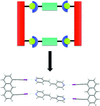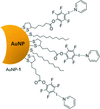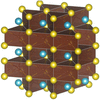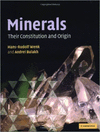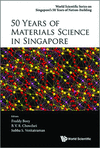issue contents
April 2017 issue
Special issue on Halogen bonding
Guest Editors: Mate Erdelyi and Pierangelo Metrangolo

Cover illustration: The map shows the function L(r) = -![[nabla]](/logos/entities/nabla_rmgif.gif) 2
2![[rho]](/logos/entities/rho_rmgif.gif) (r) superimposed with critical points of L(r) for the halogen bond in the molecular complex pyridine-diiodine [see Bartashevich et al. (2017). Acta Cryst. B73, 217-226].
(r) superimposed with critical points of L(r) for the halogen bond in the molecular complex pyridine-diiodine [see Bartashevich et al. (2017). Acta Cryst. B73, 217-226].
editorial
Free 

The Guest Editors of the special issue, Mate Erdelyi and Pierangelo Metrangolo, introduce a collection of papers presented at the 2nd International Symposium on Halogen Bonding.
scientific commentaries
Free 

Comment on article by Sirohiwal et al. [Acta Cryst. (2017), B73, 140–152] in this special issue on halogen bonding.
Free 

The paper by Szell et al. [Acta Cryst. (2017), B73, 153–162] in this special issue devoted to halogen bonding illustrates recent developments associated with this interaction in crystal engineering, unravelling here unusual trends of a coordination chemistry of halide anions.
halogen bonding
Download citation


Download citation


We report the experimental observation of a `unique' and `rare' F⋯O interaction, involving two electronegative atoms, having the characteristics of `short interatomic distance' and `high directionality' that provide robustness to the crystal packing. The characterization of these F⋯O contacts via different computational procedures establish the interaction to be dispersive in nature and the mutual polarization of an O atom by F and vice versa provides real physical insights into the role of atomic polarizability in interacting atoms in molecules in crystals.
CCDC reference: 1477385
Download citation


Download citation


Single-crystal X-ray diffraction structures are reported for a series of seven halogen-bonded cocrystals featuring 1,3,5-tris(iodoethynyl)-2,4,6-trifluorobenzene as the halogen-bond donor, and bromide ions (as ammonium or phosphonium salts) as the halogen-bond acceptors. Detailed NMR analyses (in solution and in the solid state) of this halogen-bond donor are also presented.
Download citation


Download citation


A new tecton, 1,8-diiodoethynylanthracene, with two halogen-bond donor sites was synthesized and characterized. This tecton is capable of forming two parallel halogen bonds at once, which makes it a useful building block for the construction of a variety of supramolecular squares and rectangles.
The halogen bonding–hydrogen bonding competition revisited.
Molecular self-assembly driven by halogen bonds is reported. A combination of inter- and intramolecular halogen bonds can be utilized to design supramolecular networks containing a periodic array of cyclic halogen-bonding interactions.
The combination of quantum mechanics/molecular mechanics-driven (QM/MM) docking with MM/GBSA (generalized-Born/surface area) scoring was used to reproduce protein–ligand experimental geometries with halogen bonding. This combination outperformed the Glide SP and XP scoring functions, as well as the recently published approach of dedicated halogen bonding.
The π-hole of triphosphorus hydride (P3H3) and its derivatives Z3X3 (Z = P, As; X = H, F, Cl, Br) were discovered. The relative π-hole interactions belong to the closed-shell noncovalent interaction and the stabilization mainly results from electrostatic energy.
Download citation


Download citation


Investigation of halogen-bond hard–soft acid–base complementarity in solution and solid-phases is presented.
Download citation


Download citation


The yellow cocrystal was assembled by 1,4-diiodotetrafluorobenzene and non-planar phenothiazine with a butterfly shape mainly by C—I⋯π, C—I⋯N and C—I⋯S halogen bonds. The cocrystal emits weak phosphorescence and relatively strong delayed fluorescence.
CCDC reference: 1510842
The manifestation of atomic electron density anisotropy along and across the iodine–iodine halogen bond in organic polyiodide crystals is elucidated in terms of the Laplacian of electron density, one-electron potential and electron localization function.
Download citation


Download citation


Halogen bonding stabilizes a cis-azobenzene derivative in the solid state: a crystallographic study
We show by single-crystal X-ray diffraction studies and computational analysis that halogen bonding can stabilize a metastable cis-azobenzene derivative in the solid state.
Download citation


Download citation


The supramolecular assembly of a new crystalline uranyl 3-bromo-5-iodobenzoic acid coordination polymer displaying unique bifurcated halogen–oxo interactions is described, and the vibrational and luminescent spectroscopic manifestations thereof have been explored.
CCDC reference: 1510330
Download citation


Download citation


The aim of this research is to perform a complete structural description of a new halogen bonding (XB) donor, which will be used for the surface functionalization of gold nanoparticles (AuNPs). Crystallographic studies of simple model systems will be used to determine the recognition capabilities of the synthesized XB donor, and the functionalization of the AuNPs with the XB donor and their solubility profile in different solvents will be described.
Download citation


Download citation


A series of phosphorescence cocrystals was successfully constructed from 1,4-diiodotetrafluorobenzene (1,4-DITFB) and 4,7-dimethyl-/4,7-diphenyl-/4,7-dichloro-1,10-phenanthroline (DMPhe, DPPhe, DClPhe) via C—I⋯N halogen bonding.
The competitive and orthogonal relationships between halogen bonds and the more ubiquitous hydrogen bond are reviewed, focusing on how these affect the structure of biological molecules and protein–ligand complexes.
Download citation


Download citation


The nature of E2X2 σ(4c–6e) of the X---E—E---X type in 1-(8-XC10H6)E–E(C10H6X-8′)-1′ [(1) E, X = S, Cl; (2) S, Br; (3) Se, Cl; (4) Se, Br] is elucidated with quantum theory of atoms in molecules (QTAIM) after structural determination of (1), (3) and (4). In the case of E---X, the nature of a typical-hydrogen bond (t-HB) with no covalency is predicted for (1) and (3), a t-HB with covalency is predicted for (4), and the t-HB seems intermediate for (2).
research papers
Download citation


Download citation


The incommensurately modulated twin structure of nyerereite Na1.64K0.36Ca(CO3)2 has been first determined and then compared with the modulated structure of γ-Na2CO3.
B-IncStrDB reference: 13132EqHfCe
CCDC reference: 1525102
Download citation


Download citation


This paper describes the molecular displacement of the hydrogen-bonded array as the driving force of the observed structural phase transition in isonicotinamide–4-methoxybenzoic acid co-crystal at Tc = 142.5 (5) K.
Download citation


Download citation


A potential Cu/V-organophosphonate platform for tailored void spaces via terpyridine mold casting is reported.
Download citation


Download citation


Thermal valence tautomerism in the cobalt-bis(dioxolene) molecular complexes is evaluated using variable-temperature crystal structure studies. In the present study, the effects of lattice solvent and substitution of halogens on the pyridine ligand to the valence tautomerism are demonstrated in cobalt bis(dioxolene) molecular complexes.
Download citation


Download citation


The paper describes the triclinic distortion of multiferroic BiMn7O12. The anisotropic hkl-dependent peak shape by spherical harmonics was used to model crystal structure distortion at room temperature and below, and the distortion analysis was successfully performed using the ISODISTORT program.
CCDC reference: 1527727
book reviews
Free 

Free 



 journal menu
journal menu
















